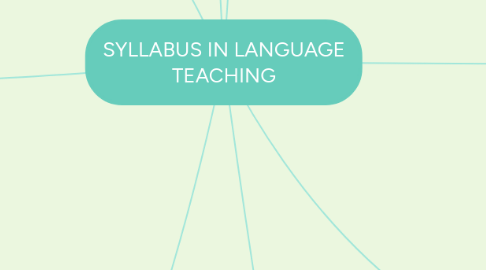
1. * Make a list of tasks that students need to develop according to their language disadvantages.
2. CONTENT-BASED
2.1. TEACHER PURPOSES
2.1.1. * Teach some content or information using the language that the students are also learning.
2.1.2. * Give students the ability in the community language that they did not have proficiency in, leading, ideally, to billinguism.
2.1.3. * Make students feel satisfied with the purpose of learning the target language and at the same time, acquiring new information.
2.2. STUDENT PURPOSES
2.2.1. * Use the foreign language to study other subjects such as: Science, Maths, Biology, etc.
2.2.2. * Learn not only the subject, but improve their language use at the same time.
2.2.3. * Comprehend the target language and the content material.
3. SKILL-BASED
3.1. TEACHER PURPOSES
3.1.1. * Develop their students' language skills using the target language.
3.1.2. * Predict the materials that their students really need in relation to each skill.
3.1.3. * Reinforce student skills.
3.2. STUDENT PURPOSES
3.2.1. * Develop their communicative competence using different resources.
3.2.2. * Be able to do, as a result of an instruction.
3.2.3. * Develop the abilities of each skill.
3.2.3.1. Reading skills
3.2.3.1.1. * Skimming * Scanning
3.2.3.2. Speaking skills
3.2.3.2.1. * Giving instructions * Delivering public talks * Asking for emergency help (Etc)
3.2.3.3. Listening skills
3.2.3.3.1. * Listening specific information over the telephone * Listening to foreign radio broadcasts for news * Taking notes in a restaurant (Etc)
3.2.3.4. Writing skills
3.2.3.4.1. * Writing specific topic sentence and certain kinds of discourse: - Memos - Research - Reports (Etc)
4. TASK-BASED
4.1. STUDENT PURPOSES
4.1.1. * Develop their autonomous learning.
4.1.2. * Learn topics, forms and structures through tasks.
4.1.3. * Learn to carry out activities using the target language.
4.1.4. *Learn through situations provided by themselves.
4.2. TEACHER PURPOSES
4.2.1. * Give students the opportunity to learn and reinforce their knowledge outside the classroom.
4.2.2. * Include a series of purposeful tasks that language learners need to perform in order to develop their learning.
4.2.3. * Provide motivation to their students through immediacy and relevancy.
4.2.4. * Teach their students to apply cognitive processes of evaluation, selection, combination, modification, or supplementation to a combination of new and old information.
5. GRAMMAR
5.1. TEACHER PURPOSES
5.1.1. * Blend the grammatical syllabus with other elements.
5.1.2. Teaching facilities as there are available materials, textbooks.
5.1.3. * Move progressively through the syllabus until, theoretically, all the structures of the teaching language have been taught.
5.1.4. * They may use either Audio-lingual Method or Grammar Translation Method.
5.2. STUDENT PURPOSES
5.2.1. * They can develop their writing skills.
5.2.2. * They will learn adequate basic vocabulary.
5.2.3. * They can move from simpler to more complex grammatical structures.
6. FUNCTIONAL
6.1. TEACHER PURPOSES
6.1.1. * Use a variety of classroom techniques to develop their students communicative language according with notional and functional content.
6.1.2. * Develop appropriate functional ability in students.
6.1.3. * Communicative ability will be more likely to result with the association of form and meaning.
6.2. STUDENT PURPOSES
6.2.1. * Learn how to use the target language to express their own ideas, notions and points of views.
6.2.2. * Learn part of the language which they are badly without wasting their time and energy for detailed study of the whole language system.
6.2.3. * Have more experience and knowledge in real or simulated interaction in the language.
7. SITUATIONAL
7.1. STUDENT PURPOSES
7.1.1. * Learn grammar, build vocabulary and develop four basic skills in particular situations.
7.1.2. * Understand the application of structure and vocabulary indirectly in a conversation.
7.1.3. * Use real-life needs and activities as learning experiences.
7.1.4. * Be able to practice simple conversation in different contexts.
7.2. TEACHER PURPOSES
7.2.1. * Organize the contents according the situations in which certain language is likely to be employed.
7.2.2. * Investigate and analyze the student needs with the daily life creating different activities based on the situation to solve them.
7.2.3. * Keep in mind the essential component of this syllabus is a non-linguistic category like the situation.
7.2.4. * Predict those situations in which students will find him/herself and applies these situations as a basis for selecting and presenting language content.
7.2.4.1. * Seeing the dentist * Going to the cinema * Meeting a new student (Etc)
7.2.5. * Differentiate the three types of situational syllabus:
7.2.5.1. * Limbo: it is one in which the specific setting of the situation is of little or no importance ( Introductions at a party).
7.2.5.2. * Concrete: it is one in which the situations are enacted specific settings, and what is important is the setting and the language associated Whit it (ordering a meal in a restaurant).
7.2.5.3. *Mythical: it is one that depends on some sort of fictional story line, frequently with a fictional cast of characters in a fictional place.
